Thai vs Alsatian Community Comparison
COMPARE
Thai
Alsatian
Social Comparison
Social Comparison
Thais
Alsatians
10,191
SOCIAL INDEX
99.4/ 100
SOCIAL RATING
2nd/ 347
SOCIAL RANK
4,075
SOCIAL INDEX
38.3/ 100
SOCIAL RATING
206th/ 347
SOCIAL RANK
Alsatian Integration in Thai Communities
The statistical analysis conducted on geographies consisting of 81,063,647 people shows a poor positive correlation between the proportion of Alsatians within Thai communities in the United States with a correlation coefficient (R) of 0.176. On average, for every 1% (one percent) increase in Thais within a typical geography, there is an increase of 0.001% in Alsatians. To illustrate, in a geography comprising of 100,000 individuals, a rise of 1,000 Thais corresponds to an increase of 1.1 Alsatians.
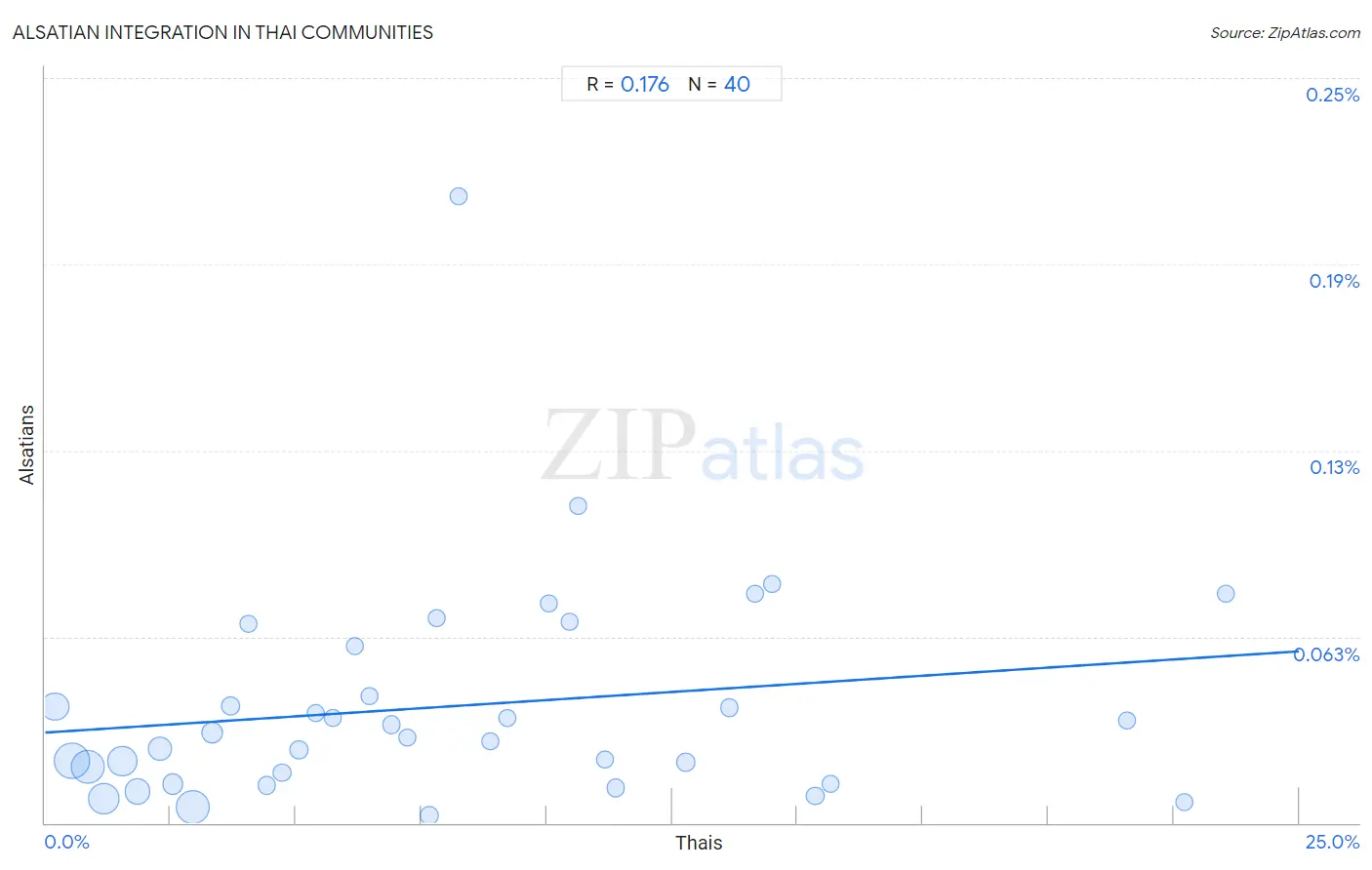
Thai vs Alsatian Income
When considering income, the most significant differences between Thai and Alsatian communities in the United States are seen in median male earnings ($72,135 compared to $55,380, a difference of 30.3%), median household income ($110,648 compared to $85,053, a difference of 30.1%), and householder income ages 45 - 64 years ($129,560 compared to $100,435, a difference of 29.0%). Conversely, both communities are more comparable in terms of per capita income ($54,307 compared to $47,284, a difference of 14.8%), householder income over 65 years ($72,099 compared to $61,797, a difference of 16.7%), and median female earnings ($47,577 compared to $40,060, a difference of 18.8%).

| Income Metric | Thai | Alsatian |
| Per Capita Income | Exceptional $54,307 | Exceptional $47,284 |
| Median Family Income | Exceptional $131,281 | Average $103,010 |
| Median Household Income | Exceptional $110,648 | Average $85,053 |
| Median Earnings | Exceptional $59,237 | Good $47,023 |
| Median Male Earnings | Exceptional $72,135 | Good $55,380 |
| Median Female Earnings | Exceptional $47,577 | Good $40,060 |
| Householder Age | Under 25 years | Exceptional $59,187 | Tragic $49,267 |
| Householder Age | 25 - 44 years | Exceptional $121,778 | Average $95,059 |
| Householder Age | 45 - 64 years | Exceptional $129,560 | Average $100,435 |
| Householder Age | Over 65 years | Exceptional $72,099 | Good $61,797 |
| Wage/Income Gap | Tragic 30.5% | Exceptional 24.7% |
Thai vs Alsatian Poverty
When considering poverty, the most significant differences between Thai and Alsatian communities in the United States are seen in child poverty among boys under 16 (11.7% compared to 19.1%, a difference of 63.4%), child poverty under the age of 16 (11.6% compared to 18.6%, a difference of 61.2%), and child poverty among girls under 16 (11.8% compared to 18.6%, a difference of 57.4%). Conversely, both communities are more comparable in terms of seniors poverty over the age of 75 (10.9% compared to 12.6%, a difference of 15.0%), seniors poverty over the age of 65 (9.2% compared to 11.3%, a difference of 22.2%), and single father poverty (14.5% compared to 17.8%, a difference of 22.7%).
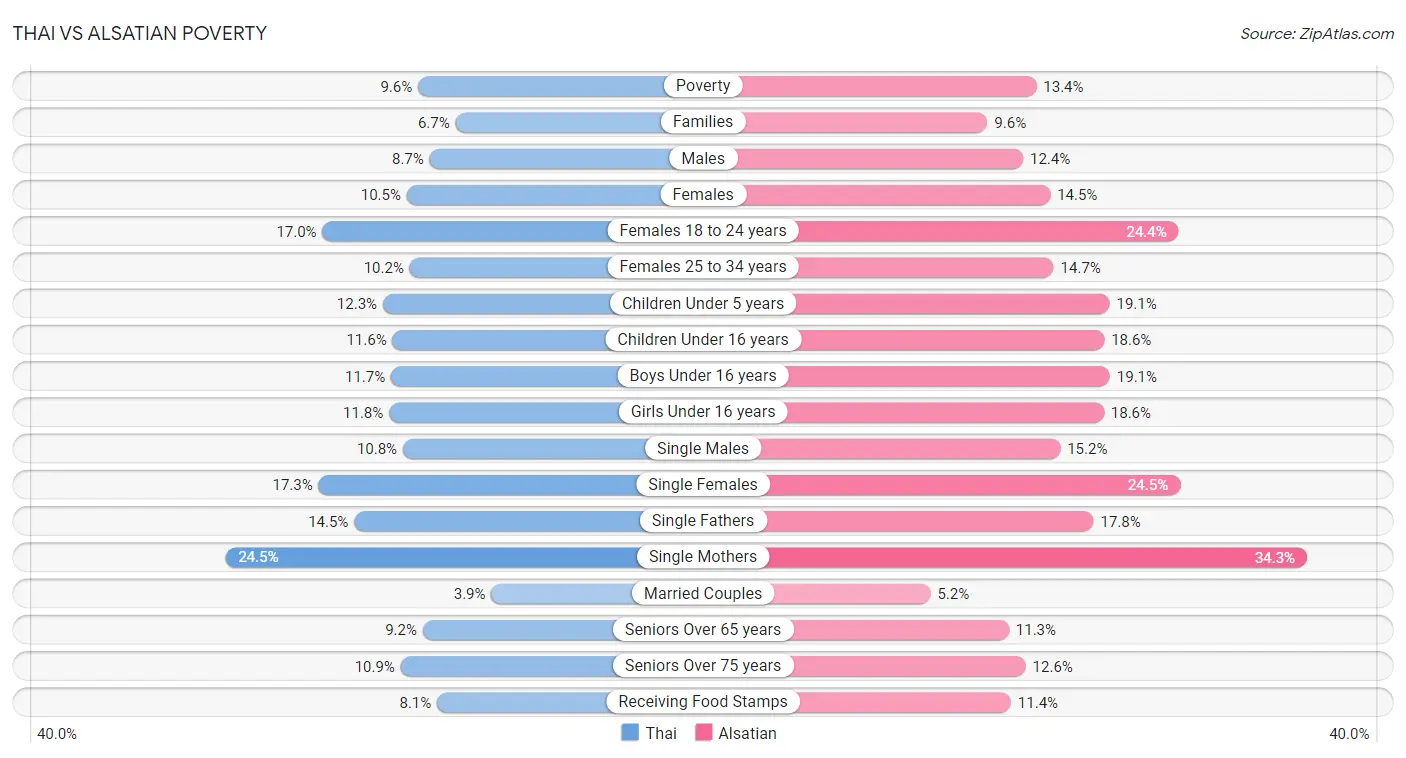
| Poverty Metric | Thai | Alsatian |
| Poverty | Exceptional 9.6% | Tragic 13.4% |
| Families | Exceptional 6.7% | Poor 9.6% |
| Males | Exceptional 8.7% | Tragic 12.4% |
| Females | Exceptional 10.5% | Tragic 14.5% |
| Females 18 to 24 years | Exceptional 17.0% | Tragic 24.4% |
| Females 25 to 34 years | Exceptional 10.2% | Tragic 14.7% |
| Children Under 5 years | Exceptional 12.3% | Tragic 19.1% |
| Children Under 16 years | Exceptional 11.6% | Tragic 18.6% |
| Boys Under 16 years | Exceptional 11.7% | Tragic 19.1% |
| Girls Under 16 years | Exceptional 11.8% | Tragic 18.6% |
| Single Males | Exceptional 10.8% | Tragic 15.2% |
| Single Females | Exceptional 17.3% | Tragic 24.5% |
| Single Fathers | Exceptional 14.5% | Tragic 17.8% |
| Single Mothers | Exceptional 24.5% | Tragic 34.3% |
| Married Couples | Exceptional 3.9% | Average 5.2% |
| Seniors Over 65 years | Exceptional 9.2% | Fair 11.3% |
| Seniors Over 75 years | Exceptional 10.9% | Poor 12.6% |
| Receiving Food Stamps | Exceptional 8.1% | Good 11.4% |
Thai vs Alsatian Unemployment
When considering unemployment, the most significant differences between Thai and Alsatian communities in the United States are seen in unemployment among seniors over 75 years (8.3% compared to 6.1%, a difference of 36.5%), unemployment among ages 35 to 44 years (3.9% compared to 5.2%, a difference of 31.7%), and unemployment among ages 16 to 19 years (15.7% compared to 20.5%, a difference of 30.3%). Conversely, both communities are more comparable in terms of unemployment among women with children ages 6 to 17 years (7.8% compared to 8.0%, a difference of 2.0%), unemployment among ages 20 to 24 years (10.0% compared to 10.3%, a difference of 3.4%), and unemployment among seniors over 65 years (5.0% compared to 5.2%, a difference of 5.6%).
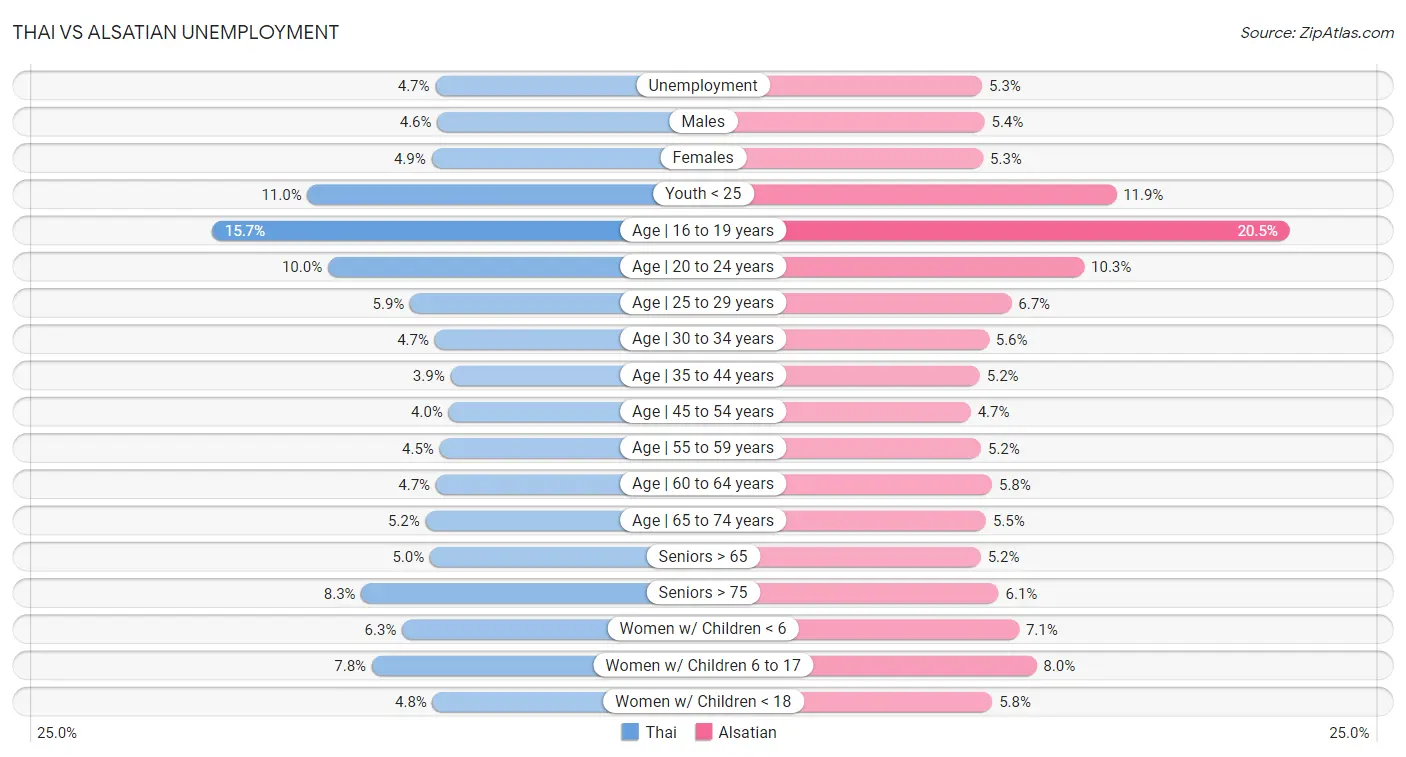
| Unemployment Metric | Thai | Alsatian |
| Unemployment | Exceptional 4.7% | Fair 5.3% |
| Males | Exceptional 4.6% | Poor 5.4% |
| Females | Exceptional 4.9% | Fair 5.3% |
| Youth < 25 | Exceptional 11.0% | Tragic 11.9% |
| Age | 16 to 19 years | Exceptional 15.7% | Tragic 20.5% |
| Age | 20 to 24 years | Exceptional 10.0% | Average 10.3% |
| Age | 25 to 29 years | Exceptional 5.9% | Fair 6.7% |
| Age | 30 to 34 years | Exceptional 4.7% | Poor 5.6% |
| Age | 35 to 44 years | Exceptional 3.9% | Tragic 5.2% |
| Age | 45 to 54 years | Exceptional 4.0% | Tragic 4.7% |
| Age | 55 to 59 years | Exceptional 4.5% | Tragic 5.2% |
| Age | 60 to 64 years | Exceptional 4.7% | Tragic 5.8% |
| Age | 65 to 74 years | Exceptional 5.2% | Tragic 5.5% |
| Seniors > 65 | Exceptional 5.0% | Poor 5.2% |
| Seniors > 75 | Exceptional 8.3% | Exceptional 6.1% |
| Women w/ Children < 6 | Exceptional 6.3% | Exceptional 7.1% |
| Women w/ Children 6 to 17 | Exceptional 7.8% | Exceptional 8.0% |
| Women w/ Children < 18 | Exceptional 4.8% | Tragic 5.8% |
Thai vs Alsatian Labor Participation
When considering labor participation, the most significant differences between Thai and Alsatian communities in the United States are seen in in labor force | age > 16 (67.2% compared to 64.7%, a difference of 3.8%), in labor force | age 16-19 (34.6% compared to 35.9%, a difference of 3.8%), and in labor force | age 45-54 (84.3% compared to 81.3%, a difference of 3.7%). Conversely, both communities are more comparable in terms of in labor force | age 30-34 (85.2% compared to 85.2%, a difference of 0.050%), in labor force | age 35-44 (85.2% compared to 84.4%, a difference of 0.89%), and in labor force | age 20-24 (74.0% compared to 74.8%, a difference of 1.1%).

| Labor Participation Metric | Thai | Alsatian |
| In Labor Force | Age > 16 | Exceptional 67.2% | Poor 64.7% |
| In Labor Force | Age 20-64 | Exceptional 80.9% | Tragic 79.1% |
| In Labor Force | Age 16-19 | Tragic 34.6% | Poor 35.9% |
| In Labor Force | Age 20-24 | Tragic 74.0% | Fair 74.8% |
| In Labor Force | Age 25-29 | Exceptional 85.5% | Tragic 83.9% |
| In Labor Force | Age 30-34 | Exceptional 85.2% | Exceptional 85.2% |
| In Labor Force | Age 35-44 | Exceptional 85.2% | Average 84.4% |
| In Labor Force | Age 45-54 | Exceptional 84.3% | Tragic 81.3% |
Thai vs Alsatian Family Structure
When considering family structure, the most significant differences between Thai and Alsatian communities in the United States are seen in births to unmarried women (24.0% compared to 33.8%, a difference of 40.7%), family households with children (30.6% compared to 25.3%, a difference of 21.2%), and single mother households (5.2% compared to 6.2%, a difference of 18.1%). Conversely, both communities are more comparable in terms of average family size (3.22 compared to 3.14, a difference of 2.6%), family households (67.2% compared to 61.7%, a difference of 8.9%), and currently married (50.9% compared to 45.7%, a difference of 11.2%).

| Family Structure Metric | Thai | Alsatian |
| Family Households | Exceptional 67.2% | Tragic 61.7% |
| Family Households with Children | Exceptional 30.6% | Tragic 25.3% |
| Married-couple Households | Exceptional 51.9% | Tragic 44.8% |
| Average Family Size | Fair 3.22 | Tragic 3.14 |
| Single Father Households | Exceptional 1.9% | Exceptional 2.1% |
| Single Mother Households | Exceptional 5.2% | Good 6.2% |
| Currently Married | Exceptional 50.9% | Poor 45.7% |
| Divorced or Separated | Exceptional 10.2% | Excellent 11.9% |
| Births to Unmarried Women | Exceptional 24.0% | Tragic 33.8% |
Thai vs Alsatian Vehicle Availability
When considering vehicle availability, the most significant differences between Thai and Alsatian communities in the United States are seen in no vehicles in household (8.2% compared to 13.2%, a difference of 60.8%), 4 or more vehicles in household (6.2% compared to 5.4%, a difference of 15.4%), and 2 or more vehicles in household (57.9% compared to 52.5%, a difference of 10.4%). Conversely, both communities are more comparable in terms of 1 or more vehicles in household (91.9% compared to 87.1%, a difference of 5.5%), 3 or more vehicles in household (19.8% compared to 18.0%, a difference of 10.4%), and 2 or more vehicles in household (57.9% compared to 52.5%, a difference of 10.4%).

| Vehicle Availability Metric | Thai | Alsatian |
| No Vehicles Available | Exceptional 8.2% | Tragic 13.2% |
| 1+ Vehicles Available | Exceptional 91.9% | Tragic 87.1% |
| 2+ Vehicles Available | Exceptional 57.9% | Tragic 52.5% |
| 3+ Vehicles Available | Good 19.8% | Tragic 18.0% |
| 4+ Vehicles Available | Fair 6.2% | Tragic 5.4% |
Thai vs Alsatian Education Level
When considering education level, the most significant differences between Thai and Alsatian communities in the United States are seen in doctorate degree (2.8% compared to 2.1%, a difference of 28.8%), master's degree (21.7% compared to 16.9%, a difference of 28.6%), and bachelor's degree (50.1% compared to 41.0%, a difference of 22.1%). Conversely, both communities are more comparable in terms of kindergarten (98.2% compared to 98.1%, a difference of 0.11%), 1st grade (98.1% compared to 98.0%, a difference of 0.11%), and nursery school (98.2% compared to 98.1%, a difference of 0.12%).
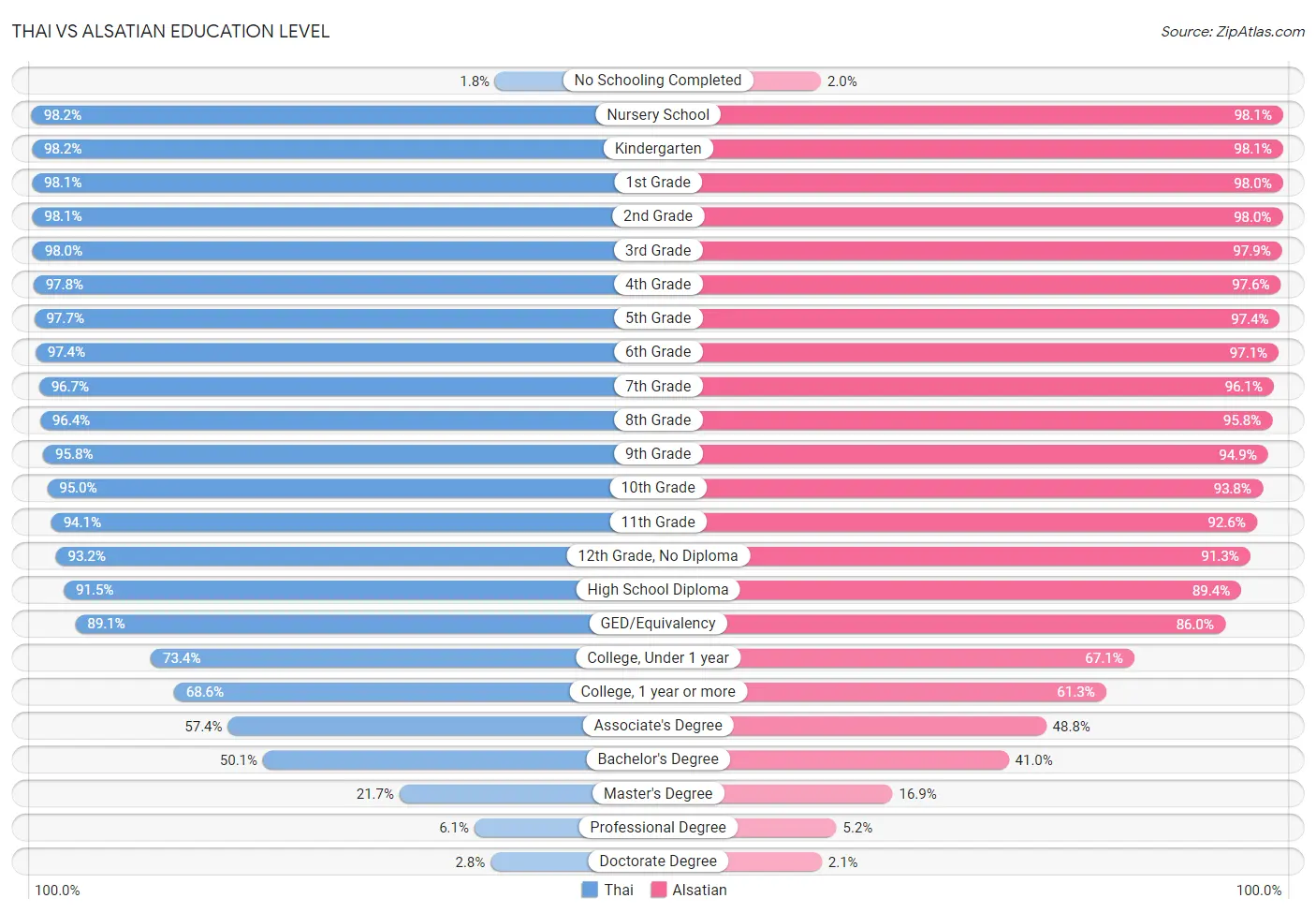
| Education Level Metric | Thai | Alsatian |
| No Schooling Completed | Exceptional 1.8% | Good 2.0% |
| Nursery School | Exceptional 98.2% | Excellent 98.1% |
| Kindergarten | Exceptional 98.2% | Excellent 98.1% |
| 1st Grade | Exceptional 98.1% | Excellent 98.0% |
| 2nd Grade | Exceptional 98.1% | Excellent 98.0% |
| 3rd Grade | Exceptional 98.0% | Good 97.9% |
| 4th Grade | Exceptional 97.8% | Good 97.6% |
| 5th Grade | Exceptional 97.7% | Good 97.4% |
| 6th Grade | Exceptional 97.4% | Good 97.1% |
| 7th Grade | Exceptional 96.7% | Good 96.1% |
| 8th Grade | Exceptional 96.4% | Good 95.8% |
| 9th Grade | Exceptional 95.8% | Average 94.9% |
| 10th Grade | Exceptional 95.0% | Average 93.8% |
| 11th Grade | Exceptional 94.1% | Good 92.6% |
| 12th Grade, No Diploma | Exceptional 93.2% | Average 91.3% |
| High School Diploma | Exceptional 91.5% | Good 89.4% |
| GED/Equivalency | Exceptional 89.1% | Good 86.0% |
| College, Under 1 year | Exceptional 73.4% | Exceptional 67.1% |
| College, 1 year or more | Exceptional 68.6% | Exceptional 61.3% |
| Associate's Degree | Exceptional 57.4% | Exceptional 48.8% |
| Bachelor's Degree | Exceptional 50.1% | Exceptional 41.0% |
| Master's Degree | Exceptional 21.7% | Exceptional 16.9% |
| Professional Degree | Exceptional 6.1% | Exceptional 5.2% |
| Doctorate Degree | Exceptional 2.8% | Exceptional 2.1% |
Thai vs Alsatian Disability
When considering disability, the most significant differences between Thai and Alsatian communities in the United States are seen in disability age 35 to 64 (8.6% compared to 11.8%, a difference of 37.7%), vision disability (1.7% compared to 2.3%, a difference of 34.6%), and male disability (9.2% compared to 11.7%, a difference of 27.2%). Conversely, both communities are more comparable in terms of disability age over 75 (45.4% compared to 47.3%, a difference of 4.2%), cognitive disability (16.1% compared to 17.7%, a difference of 9.5%), and disability age under 5 (1.1% compared to 1.2%, a difference of 13.4%).
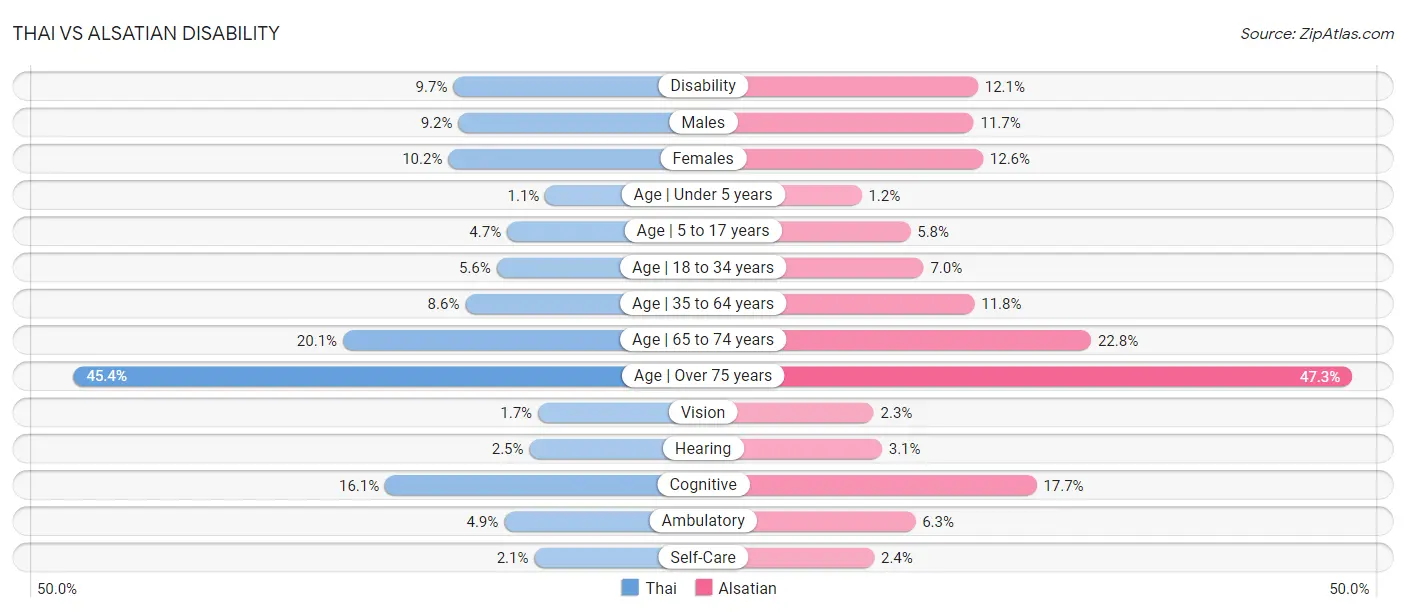
| Disability Metric | Thai | Alsatian |
| Disability | Exceptional 9.7% | Tragic 12.1% |
| Males | Exceptional 9.2% | Tragic 11.7% |
| Females | Exceptional 10.2% | Tragic 12.6% |
| Age | Under 5 years | Exceptional 1.1% | Good 1.2% |
| Age | 5 to 17 years | Exceptional 4.7% | Tragic 5.8% |
| Age | 18 to 34 years | Exceptional 5.6% | Tragic 7.0% |
| Age | 35 to 64 years | Exceptional 8.6% | Tragic 11.8% |
| Age | 65 to 74 years | Exceptional 20.1% | Excellent 22.8% |
| Age | Over 75 years | Exceptional 45.4% | Average 47.3% |
| Vision | Exceptional 1.7% | Tragic 2.3% |
| Hearing | Exceptional 2.5% | Poor 3.1% |
| Cognitive | Exceptional 16.1% | Tragic 17.7% |
| Ambulatory | Exceptional 4.9% | Poor 6.3% |
| Self-Care | Exceptional 2.1% | Exceptional 2.4% |